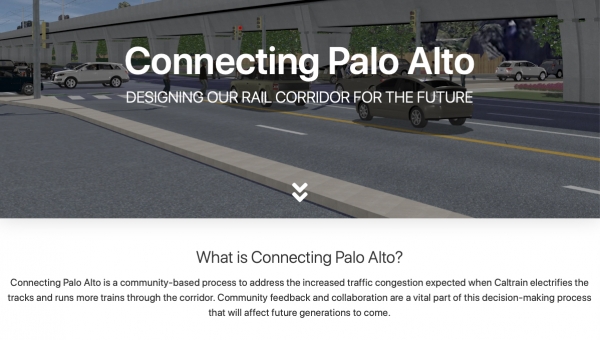Last Thursday I attended a meeting of the Palo Alto Expanded Community Advisory Panel (XCAP). The Palo Alto City Council gave this group of fourteen Palo Altans and stakeholders the responsibilities to evaluate all the information associated with a final set of grade separation alternatives and for recommending a preferred grade solution - all by April 2020. The XCAP acts as a Brown Act body that communicates directly to the City Council. The group is required to employ a transparent (public) consensus-driven planning process that fairly addresses conflicting community views. The creation of the XCAP illustrates how Palo Alto proactively solicits community input and feedback.
Here are important benefits that Palo Alto 's planning process can produce. Most are currently far beyond Menlo Park's reach.
• The selected solution best serves the needs of BOTH the entire community and
individual neighborhoods.
• The community can easily stay well-informed and understand the rationale for all significant trade-offs the City Council makes.
• The community knows its interests and concerns were fairly and transparently considered. This minimizes frustrations and divisive behavior.
• The community is more receptive to approving project funding.
• The city takes advantage of knowledgeable and talented community members who are either unable or uninterested in joining city commissions.
• The city is in a stronger position to negotiate with necessary partners, e.g., Caltrain.
• The city is in a strong position to obtain needed funds from county, state and federal sources.
• Large and complex civic projects often generate “second-guessing” once started. Community outreach and engagement in the planning process can reduce the frequency and severity of these disruptive demands on the City Council.

Here are some of the ways Palo Alto currently engages its community in the project planning process for grade separations:
• The XCAP advisory committee is expected to proactively collect resident input and feedback and make recommendations.
• Residents are encouraged to participate in both REGULAR city council project reviews and REGULAR XCAP meetings.
* Palo Alto is evaluating ALL potential grade separation alternatives - tunnel, viaduct, vehicle underpass and hybrid (raises tracks and lowers streets) - at each of four crossings.
• The city has a dedicated grade separation website that enables residents to easily understand the planning process plus project history, progress, and schedules.
• The city also has a grade separation blog that provides regular project news and updates.

Here are the ways Menlo Park currently engages its community in the grade separation planning process.
• Menlo Park does not have a community advisory council. (A small group of residents has attempted to informally fill this gap for the past two years, spending hundreds of hours on research, analyses and recommendations, but it has had little impact on city decisions.)
• Only two city council project reviews were held in 2019 (January and July) and none are scheduled for the rest of the year.
• Only one Rail Subcommittee meeting was held in 2019 (July) and none are currently scheduled for the rest of the year.
* Menlo park is NOT evaluating all possible grade separation alternatives .Unfortunately, residents have NOT had the opportunity to fairly evaluate viaduct designs and compare them three studied alternatives. In January 2018 the city council directed city staff to develop a proposal for the study of alternatives that would fully elevate tracks between Glenwood and Ravenswood. After almost two years no study has been approved and residents cannot be confident that they will have the opportunity to evaluate a potentially better solution than the one that is currently preferred by the city council.
• The Menlo Park city website does not provide residents convenient ways to stay informed about its grade separation project. Instead, dozens of links offer access to a large collection of individual meeting agendas, reports, minutes and videos; consultant presentations, project documents, and emails in the City Council archive. There are very few user-friendly communications tools.
• There is no convenient way for residents to understand the overall workplan for this project, and many key milestones remain unscheduled.
I appreciate the steady hard work and contributions of the Menlo Park City Council and city staff. Too often their work is both difficult and thankless. They must deal with an endless stream of operational city items and evaluate lots of challenging proposals for new private developments like the huge expansion of the Facebook campus. Unfortunately, this work leaves little bandwidth for planning large and complex civic projects. Add to this the fact the city’s existing planning process is unnecessarily burdensome and it’s easy to understand why our community is denied excellent opportunities to stay well-informed and make contributions. I have observed this not only with the grade separation project, but also with the earlier El Camino Corridor Study and the stuttering investigations of additional downtown parking, e.g., parking structures. Also, most of the civic improvements our community proposed in the Downtown Specific Plan in 2012 have not been implemented.
I recommend that the Menlo Park City Council adopt a truly community-driven planning philosophy and process and implement many of the tools used by Palo Alto. A good start would be to talk to Palo Alto’s council members and city manager, and then assign community outreach responsibilities to a dedicated marketing communications staff member.



